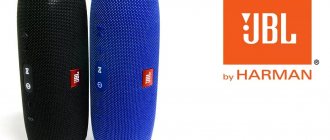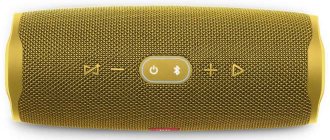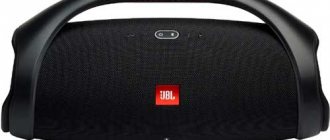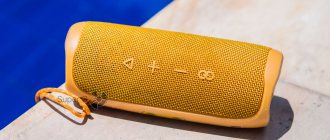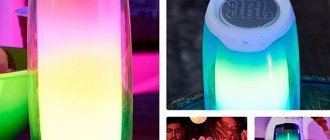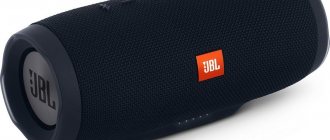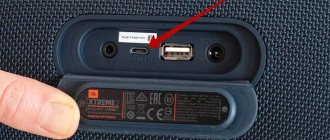Fans of headphones and speakers have known the JBL brand for a long time as a company famous for its audio devices. The new JBL Charge 5 is not only a waterproof wireless speaker, but also a portable battery (power bank).
The Charge 5 speaker from JBL is good in many other aspects. There is a PartyBoost function that allows you to combine several speakers into a single system, and the case is incredibly reliable and protected from water. Charge 5 costs from 10 thousand rubles, which is quite a lot by modern standards. Therefore, the main question is how good is the sound here compared to competitors?
JBL Charge 5 Specifications
- Transducers: LF 52×90 mm, HF 20 mm
- Rated output power: 40W
- Frequency response: 65 Hz – 20 kHz
- Signal to noise ratio: > 80 dB
- Waterproof: IP67
- Battery: 27 Wh Li-Polymer (3.6 V/7500 mAh)
- Charging time: 4 hours (5V/3A)
- Playing time: up to 20 hours (depending on volume and type of music)
- Bluetooth version: 5.1
- Ports: USB-A, USB-C, 5V/2A (max)
- Bluetooth profiles: A2DP 1.3, AVRCP 1.6
- Transmitter frequency range: 2400 MHz – 2483.5 MHz
- Dimensions and weight: 223x96.5x94 mm, 960 grams
- Price at the time of publication: from 10,000 rub.
How does it sound?
As for sound, the Link Portable speaker showed itself in the best traditions of JBL. Incredibly powerful for such small speakers and rich in sound. Neither Yandex Station Mini nor Light can exactly boast of this. Great for listening to electronic music or rock. But for music lovers of classical music and vocals, the quality is still not up to the mark - there is no detail and transparency.
But it should be noted that it was not created for these genres. For the sake of experiment, I placed it on the second floor of the house and closed the doors - as a result, at maximum volume it was perfectly audible in the corner of the house farthest from the speaker. Although at maximum settings the sound still begins to wheeze, so to get the best quality you need to listen to music at medium settings.
Waterproof design
JBL Charge 5 is a little surprising with its large dimensions and weight. However, one would hardly expect anything else from such a powerful and portable speaker.
At the same time, the weight of the device seems ideal - it corresponds to the price and high quality of the Charge 5. The same goes for the materials used. The body is wrapped in a fabric that is pleasant to the touch, and the sides are covered with rubber panels. It’s surprising that even the rubber here is of better quality than on similar competitors’ speakers.
There are also several metal elements in the design. For example, the JBL logo with imitation red lighting under the letters in the center. Although the buttons and connectors are made of plastic, they don't feel cheap. When you press the keys you will hear a pleasant click. The charging cable fits tightly into the connector and does not wobble from side to side. There are two USB connectors, but only one is covered with a plug to protect it from water.
JBL has made sure your Charge 5 lasts as long as possible. The speaker has protection against water and dust of the IP67 standard; it can be wet, but it is better not to immerse it in depth.
In general, JBL did a good job on the design. Charge 5 has become one of the company's most beautiful portable speakers. I am pleased not only with the appearance or reliability of the case, but also with the way the device feels in the hands.
Equipment
The speaker comes in a heavy square box (all together ~1.5 kg), similar to a mini-suitcase. Its quality is pleasantly surprising - bright, neat and reliable, it is suitable for transporting the speaker to a party or nature.
The column itself flaunts on the front side, and its image is glossy and stands out from the background. On the sides there are a couple more bright pictures with the provocative phrase Dare to Listen (“Don’t be afraid to listen”). The back side lists the main features in several languages, including Russian. I note that there is a holder on top - perhaps in order to “attach” the box somewhere for carrying, although the impressive weight is unlikely to allow this to be done.
There is a black “tab” at the bottom with which you can open the box and see what’s inside. This method of opening evokes the idea that we are looking at a kind of “chest”, which is also, albeit a small, plus for the Charge 5. The box lid is held on by two barely noticeable magnets, which means the risk of accidental opening is minimal.
Inside there is a case with operating instructions, a warranty card, a safety brochure and a Type-C USB cable for charging, as well as the speaker itself, neatly packed in a cotton bag.
Interesting: inside the box there is a recess for the speaker, which means it can be used as a “chest” and you don’t need to buy an additional case.
This may seem unnecessary, but the textual documentation also leaves a pleasant impression. It has been translated into 19 languages, including Russian, and contains comprehensive information about Charge 5, ranging from technical parameters to tips on how to extend the life of the battery.
It’s surprising that so much can be said just about the packaging and accessories, but there’s more to come, because now I’ll tell you about the speaker itself.
Communication and Connection
Unfortunately, the JBL Charge 5 does not have a 3.5mm jack or Wi-Fi connectivity. You can't control playback via the voice assistant, communication is only via Bluetooth, which is a little disappointing.
However, most portable Bluetooth speakers don't have Wi-Fi either, so this is a minor drawback. I'm glad that in return JBL added a couple of other interesting features here: reverse charging and PartyBoost mode.
Charge 5 quickly connected to my smartphone, the signal was always good, even at a distance of about 15 meters, in a room with walls.
Metal, plastic and rubber
The new product is similar in shape to the previous model, but this is where the common features in the design, as well as in the filling, end. HARMAN recycled everything that could be recycled, and for good reason - the company was able to improve the device both outside and inside. She also pleased with her set, which emphasizes that this accessory is perfect for traveling. In particular, in addition to the speaker itself, a large cardboard box contained a power supply with an American plug (it is also suitable for Japan), plus two adapters - for European and for British (Hong Kong) sockets.
Pay attention to the USB → micro-USB cable - it is colored and performs two functions at once: it charges the speaker itself, which has a built-in 6000 mAh , plus it is used to recharge portable devices from Charge 2 (for example, Android smartphones). The iPhone charges just like any other gadget that can replenish its energy reserves from USB:
The speaker connects to sound sources via Bluetooth 4.0 , that is, the sound quality is good - there are no hisses, crackles or any strange interruptions. If there is no wireless module in the source, then you can use a regular 3.5 mm input, however, such a cable is not included with the speakers; you will have to get it separately.
By the way, in addition to the red model, JBL has other Charge 2 options:
The speaker body is mostly made of plastic with a high-quality Soft-touch coating that does not collect fingerprints and is easy to clean from dust. A pair of 45 mm wide-range speakers with a total power of 15 watts (RMS) are covered with a metal mesh in color. Hidden on top under the rubber pad are indicators for power, Bluetooth connection, battery charge level, as well as buttons for volume control, answering/hanging up calls (aka start/pause playback) and activating Social Mode .
The latter is interesting if the speaker is listened to in the company of friends. By clicking on it, you get the opportunity to connect three audio sources via Bluetooth to Charge 2 simultaneously and listen to music from each of them in turn. You can organize unique mixes of your guests’ favorite compositions. I tested it by connecting my iPhone and MacBook at the same time - everything works and the speaker picks up music from different sources literally on the fly.
Since there is a button to accept/end calls, it means that there is also a microphone with a speakerphone function in addition. That is, you can use the accessory to receive calls and this feature works well, at least if the room is quiet. I haven't experienced it in a loud environment.
A compact stand is built into the bottom of the gadget, which securely holds it in a horizontal position, easily withstanding the positive vibrations of the acoustics at maximum volume. True, it is not designed for external influence, so it is better not to check the stability of the speaker with light kicks when it is standing on the edge of the table.
Let's finish studying the design of the device with the most interesting element - a pair of metal plates with a corporate logo on the edges of the cylinder. Let's talk about the technical part, after which we will smoothly move on to the sound. The mentioned plates are there for a reason. First, they are part of passive low-frequency radiators . Secondly, they simply vibrate and move beautifully when the speaker sounds - there is a feeling of power and the device automatically gets +100 to its sound quality.
As for the design of the speaker, there is an acoustic chamber inside it, pumped by a pair of 45 mm speakers, and due to the pressure created, the emitters are activated, significantly increasing the level of reproduced bass. By the way, this is one of the most bassy and loud speakers in its class. I can’t believe that such a little thing produces such a powerful acoustic stream, and then you look at the dancing plates at the ends and understand: “JBL engineers and designers do not eat their bread in vain.” A great example where design and technology are intertwined.
Pay attention to the greased metal plate - these are not my crooked hands, but shooting at a low shutter speed while the speaker performs a powerful bass burst, and the plate at this moment vibrates sparklingly. Impressive sight
Control buttons
Controlling the JBL Charge 5 is no different from standard (unprotected) speakers - just a light touch of the button, accompanied by a noticeable, pleasant click.
The main two control buttons, the switch and the pairing mode, are placed on an additional panel; such a panel also has a charging connector and convenient USB-C for energy transfer. The latter also meets the requirements of water resistance. The remaining keys control volume, pause and PartyBoost.
You can install the JBL Portable app to update the Charge 5 firmware or check the battery level. The app also allows you to control PartyBoost to connect to another JBL speaker in stereo or party mode. I was able to get PartyBoost to work in Charge 5 with Flip 5, but not with Charge 4.
Unfortunately, the application does not have an equalizer and does not allow you to customize the sound. There are no preset sound modes either.
First portable speaker
My first acquaintance with the Charge line took place at the third generation level. Before that, I had other models, for example, the first generation JBL Clip. And so it was then that I realized how a portable speaker could and should sound. Then I bought other series - Xtreme, Clip, Flip and Go. There probably aren't any JBL speakers left that I haven't come across through work or haven't bought for myself. My most recent purchases were the JBL Clip 4 and Xtreme 3. Now I have the Charge 5, which partially replaces both of these speakers.
In the new generation Charge, not only the brand logo has changed.
Sound quality
The volume of JBL Charge 5 is very high – the speaker can be heard even from a considerable distance. If you set the volume to 70%, the device will completely fill a two-story house with music.
The sound quality is excellent, the melodies are incredibly detailed, and there is enough power for any genre. It’s worth saying right away that the Charge 5’s sound power is excellent; the speaker will almost shake the walls. You won't easily hear the bass, but you will literally feel it. The only negative is that lower frequencies can be reproduced with errors; more precisely, the heaviest bass sometimes seems to disappear.
The fact is that the average human ear is capable of perceiving a range from 20 Hz to 20 kHz, and the frequency range of the JBL Charge 5 is 65 Hz - 20 kHz. However, in the vast majority of musical compositions, frequencies below 65 Hz are generally inaudible. Therefore, even where they exist, they do not play a decisive role. So it's unlikely that this small flaw will ruin your listening experience.
In all other respects, the Charge 5's sound is impeccable, the balance across the entire frequency range is perfectly maintained. In this aspect, the JBL speaker is one of the best in its class, of course, if you do not need an AUX input, Wi-Fi connection or other connection methods.
Why do I need JBL Link Portable?
And so I began to look for a more musically interesting alternative, so that I could put it in another room on the second floor of the house and at the same time be able to control Alice from there without straining my vocal cords. As a result, I couldn’t find anything better than a wireless speaker from a famous brand - JBL Link Portable with Alice support. If a year ago at the start of sales it cost as much as 12,000 rubles, today the price has already dropped below the psychological barrier of 10 thousand to an acceptable 8,300 rubles. And this is only 300 rubles more expensive than the new Yandex Station Mini.
JBL also has another speaker with the Yandex voice assistant - Link Music. However, it loses to Portable in terms of portability. Since it does not have a built-in battery and is stationary, rigidly tied to the location of the power cable. In essence, this is a more sound-improved version of the Yandex Station Mini itself, only from a different manufacturer.
JBL Link Portable looks much more interesting, as it can be used autonomously. But let's talk about everything in order. The speaker comes in a branded box in traditional colors - white and black with orange accents.
Additional functions
The main feature of the JBL Charge 5 is right there in the name, and in practice reverse charging turns out to be quite useful.
The speaker has a USB-C input and a USB-A output; you can use the equipment as an external battery. Of course, given the 7500 mAh capacity, you won’t be able to recharge several smartphones, at least if you’re also going to listen to music. Fully charging a modern smartphone will use at least half of the Charge 5's energy reserve.
PartyBoost mode consumes energy approximately like recharging a smartphone. The essence of the function is that you can connect several Charge 5 speakers together and get louder and more powerful stereo sound.
